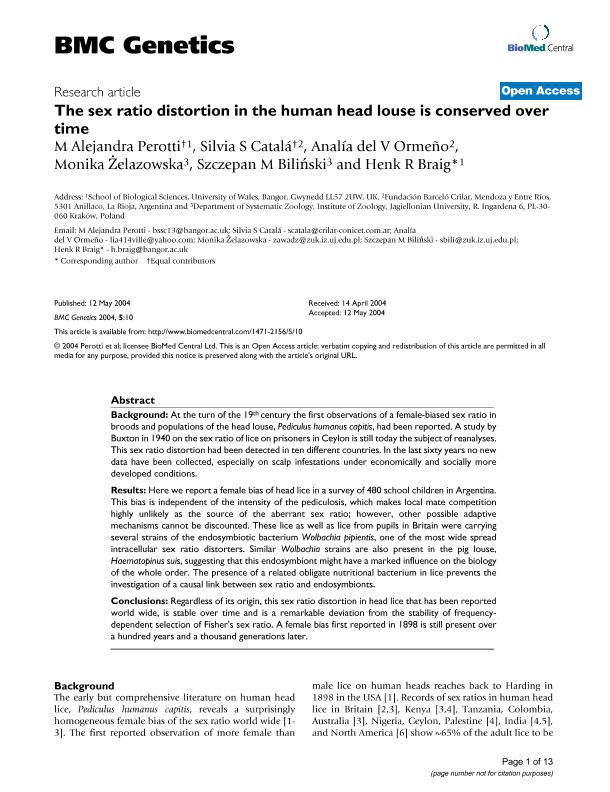Artículo
The sex ratio distortion in the human head louse is conserved over time
Perotti, Maria Alejandra; Catala, Silvia Susana ; Del Valle Ormeño, Analia; Zelazowska, Monika; Bili?ski, Szczepan M.; Braig, Henk R.
; Del Valle Ormeño, Analia; Zelazowska, Monika; Bili?ski, Szczepan M.; Braig, Henk R.
 ; Del Valle Ormeño, Analia; Zelazowska, Monika; Bili?ski, Szczepan M.; Braig, Henk R.
; Del Valle Ormeño, Analia; Zelazowska, Monika; Bili?ski, Szczepan M.; Braig, Henk R.
Fecha de publicación:
05/2004
Editorial:
BioMed Central
Revista:
BMC Genetics
ISSN:
1471-2156
Idioma:
Inglés
Tipo de recurso:
Artículo publicado
Clasificación temática:
Resumen
Background: At the turn of the 19th century the first observations of a female-biased sex ratio in broods and populations of the head louse, Pediculus humanus capitis, had been reported. A study by Buxton in 1940 on the sex ratio of lice on prisoners in Ceylon is still today the subject of reanalyses. This sex ratio distortion had been detected in ten different countries. In the last sixty years no new data have been collected, especially on scalp infestations under economically and socially more developed conditions. Results: Here we report a female bias of head lice in a survey of 480 school children in Argentina. This bias is independent of the intensity of the pediculosis, which makes local mate competition highly unlikely as the source of the aberrant sex ratio; however, other possible adaptive mechanisms cannot be discounted. These lice as well as lice from pupils in Britain were carrying several strains of the endosymbiotic bacterium Wolbachia pipientis, one of the most wide spread intracellular sex ratio distorters. Similar Wolbachia strains are also present in the pig louse, Haematopinus suis, suggesting that this endosymbiont might have a marked influence on the biology of the whole order. The presence of a related obligate nutritional bacterium in lice prevents the investigation of a causal link between sex ratio and endosymbionts. Conclusions: Regardless of its origin, this sex ratio distortion in head lice that has been reported world wide, is stable over time and is a remarkable deviation from the stability of frequency-dependent selection of Fisher's sex ratio. A female bias first reported in 1898 is still present over a hundred years and a thousand generations later.
Archivos asociados
Licencia
Identificadores
Colecciones
Articulos(CRILAR)
Articulos de CENTRO REGIONAL DE INV. CIENTIFICAS Y TRANSFERENCIA TECNOLOGICA DE ANILLACO
Articulos de CENTRO REGIONAL DE INV. CIENTIFICAS Y TRANSFERENCIA TECNOLOGICA DE ANILLACO
Citación
Perotti, Maria Alejandra; Catala, Silvia Susana; Del Valle Ormeño, Analia; Zelazowska, Monika; Bili?ski, Szczepan M.; et al.; The sex ratio distortion in the human head louse is conserved over time; BioMed Central; BMC Genetics; 5; 10; 5-2004; 1-13
Compartir
Altmétricas



